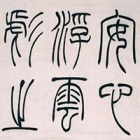Asian Gallery (Toyokan) Room 8
June 9, 2015 (Tue) - August 2, 2015 (Sun)
Around the end of the 18th century in the Qing dynasty (1616–1912), developments in “Evidential Learning,” which emphasized the need for objective evidence, stimulated the flourishing of the “Epigraphy Movement,” or the study of inscriptions on ancient bronze vessels and steles. Meanwhile, calligraphers of the “Stele School,” who were influenced by these inscriptions, brought significant change upon long-running trends in calligraphy.
Born into a poor family in Huaining of Anhui province, Deng Shiru (1743–1805) would become a central figure in the Stele School. He taught himself calligraphy and seal carving, selling calligraphic works and seals to support himself. Later he travelled extensively to further expand his insight and became the private secretary of the famous calligrapher Liang Yan. He continued his studies with great vigor while freely borrowing works from Yan’s collection. While in Beijing, an authoritative calligrapher by the name of Weng Fanggang (1733–1818) dismissed his calligraphy as that of an “uncultured person.” However, by continuing his study of ancient characters with great devotion and sincerity, he reached an unparalleled level of achievement and succeeded in brilliantly reviving the “seal” and “clerical” styles of calligraphy. He also creating a new style of cursive “running” script that was entirely different from the orthodox tradition derived from Wang Xizhi (307–365).
This exhibition features three calligraphers of the Stele School who were connected through master-pupil relationships. Foremost is Deng Shiru, who made great achievements despite never serving as a government official, Bao Shichen (1775–1855), who excelled not only as a calligrapher but also as a theorist, and Wu Xizai (1799–1870), who infused his calligraphy with a delicate sensibility while lived in honest poverty.

